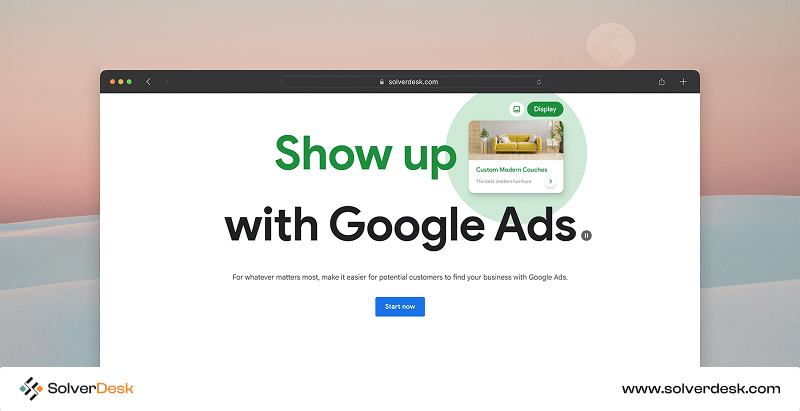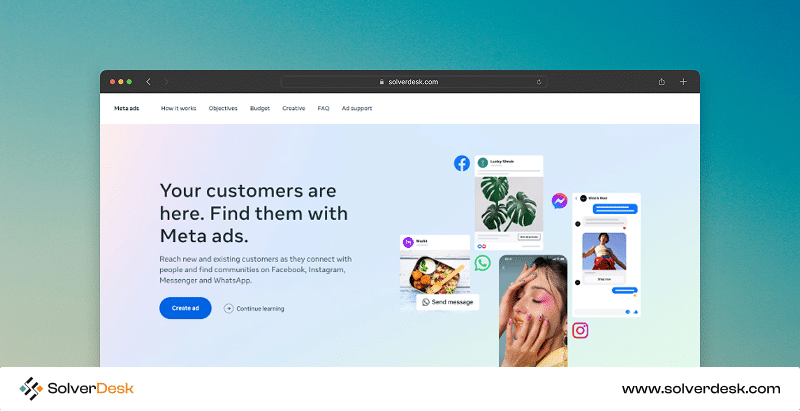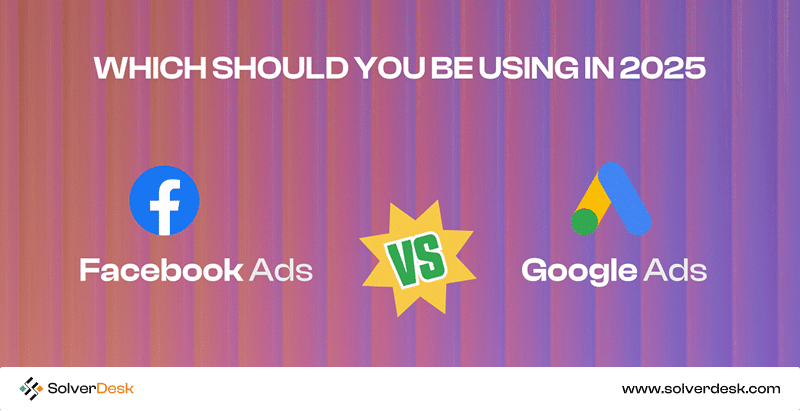What Makes Google Ads Different from Facebook Ads?
If you’re trying to choose between Google Ads and Facebook Ads in 2025, the first thing you need to understand is how each platform works and what makes them different. Both can help you reach the right people, but they do it in completely different ways. Let’s break it down.

Google Ads: Paid Search
Google Ads shows your business to people who are actively looking for something. Think of it like this: someone types “emergency plumber near me” or “best running shoes for flat feet” into Google, and your ad pops up right at the top. These are people with clear intent. They want a solution now.
What it’s based on:
- Keywords — the exact words people type into Google
- User intent — they’re ready to compare, buy, or contact
Where your ads appear:
- At the top of Google search results
- In Google Shopping listings (great for eCommerce)
- On websites across the Google Display Network
- On YouTube (through video ads)
Real-world example:
A locksmith in Chicago uses Google Ads to show up for searches like “24/7 locksmith near me.” Since people searching are in a hurry, these ads bring in fast leads and phone calls.
Best use cases:
- Local services (plumbers, dentists, electricians)
- eCommerce stores with specific products
- Businesses looking for high-intent traffic and quick conversions

Facebook Ads: Paid Social
Facebook Ads (now part of Meta Ads) shows your business to people while they’re browsing, not searching.
These are users scrolling through their feed, watching Reels, or reading posts, and your ad appears in between, based on what they like and how they behave online.
This is known as interruption-based marketing, but when done well, it feels natural and engaging.
What it’s based on:
- Demographics — age, gender, job title
- Interests — hobbies, lifestyle, brands they follow
- Behaviours — online actions, purchases, video views
Where your ads appear:
- Facebook feed
- Instagram stories and Reels
- Messenger and Facebook Marketplace
Real-world example:
A new clothing brand in Los Angeles runs Instagram Reels showing behind-the-scenes footage of their eco-friendly fabrics. People who follow sustainable fashion pages start seeing the ads. Many click through to check out the brand even though they weren’t searching for it.
Best use cases:
- New product or brand launches
- Growing a social following or email list
- Visual products that benefit from strong storytelling (clothing, beauty, wellness)
Quick Takeaway:
- Use Google Ads if you want to catch people when they’re searching with a clear goal in mind
- Use Facebook Ads if you want to build awareness, tell your story, or reach new people based on who they are, not what they typed
And if your budget allows, using both together can cover the full customer journey from awareness to decision.
Why Google Ads Might Be Right for You
Google Ads continues to be one of the most effective ways to reach people who are ready to take action. In 2025, it will become even more valuable for businesses that want high-quality leads, quick conversions, and broad visibility across devices. Let’s break down what makes it a smart choice.
High-Intent Traffic with Buyer Mindset
The biggest strength of Google Ads is that you’re showing up when people are already looking for a solution. Whether someone is searching for “best dentist in Dallas” or “affordable web design services,” they’re actively trying to make a decision, not just browsing.
This makes Google Ads especially effective for businesses that offer:
- Emergency services (plumbing, towing, HVAC)
- Local or seasonal services (tax prep, landscaping)
- Niche products that people search for directly
Real Example:
A law firm in San Diego runs Google Ads targeting keywords like “family lawyer near me” and “child custody attorney San Diego.” Since the person searching has a strong reason and is ready to act, the ad clicks often turn into consultations and clients.
Takeaway:
If your customer knows what they want and is ready to buy or book, Google Ads can put you in front of them at the exact right time.
Diverse Ad Formats Across Devices
Google isn’t just about text ads anymore. In 2025, it offers a full range of ad types that work across desktops, tablets, and especially mobile phones.
- Search Ads – Appear at the top of Google when users search for specific terms
- Display Ads – Show image-based ads on news sites, blogs, and other websites
- Shopping Ads – Feature product photos, prices, and reviews at the top of search results
- YouTube Ads – Run video campaigns to reach users watching tutorials, reviews, or entertainment
Real Example:
An online sneaker store in New York uses Shopping Ads for product visibility, YouTube Ads for reviews and unboxings, and Search Ads for people typing “buy running shoes.” Each format supports a different stage of the buying journey, and all are handled under one platform.
Takeaway:
If your product or service fits into multiple parts of the customer journey, Google gives you the tools to reach them wherever they are, whether they’re searching, reading, or watching.
Improved Targeting with First-Party Data
With privacy rules tightening, Google has adapted. Instead of relying on third-party cookies, it now uses its network (like Gmail, Search, and YouTube) to help advertisers reach the right people in a way that respects privacy.
Here’s what’s working in 2025:
- Custom Audiences – Target based on past site visits, purchases, or specific search activity
- Smart Bidding – Google automatically adjusts your bids to get better results, based on conversion data
- Conversion Tracking – You can see which clicks turned into leads, calls, or sales
Real Example:
A B2B software company in Boston runs Google Ads targeting people who searched for terms like “CRM tools for small business.” They use conversion tracking to measure which keywords bring in demo requests, and smart bidding helps improve their return week by week.
Takeaway:
If you want your ad dollars to go further, Google’s tools help you spend smarter, focusing on users most likely to take action, without overpaying.
Google Ads is a strong fit for businesses that want direct, measurable results. If your audience is actively searching for what you offer, or you have a product people already know they need, Google Ads is one of the best places to show up in 2025.
Why Facebook Ads Might Be Right for You
Facebook Ads now part of the broader Meta Ads platform remains one of the most cost-effective ways to reach people where they spend their time. In 2025, it’s especially powerful for businesses focused on growing brand awareness, building a loyal audience, and driving early-stage interest.
Here’s what makes it a smart choice.
Ultra-Precise Targeting
One of the biggest strengths of Facebook Ads is how precisely you can reach your audience. Instead of waiting for someone to search for you, you can get in front of them based on what they like, follow, or shop for.
With Facebook and Instagram connected under Meta, you can target people by:
- Interests and behaviours (e.g., fitness lovers, frequent travellers, online shoppers)
- Demographics (e.g., new parents, college students, small business owners)
- Life events and milestones (e.g., birthdays, moving to a new city, getting engaged)
Real Example:
A handmade candle brand in Nashville used Facebook Ads to target women aged 25–45 who liked home decor pages and shopped online. They ran ads showing their newest collection with a 10% discount. Within two weeks, they sold out their first batch.
Takeaway:
If you know who your ideal customer is, even if they’re not looking for you yet, Facebook Ads can put your business right in front of them.
Visually Engaging Formats That Boost Brand Recall
Facebook and Instagram are built for visual content, and that’s what makes them perfect for storytelling. In 2025, mobile-first video ads and image carousels are some of the most effective ways to catch attention and stay memorable.
You can use formats like:
- Reels and Stories – Short, vertical videos that feel native to the platform
- Carousel ads – Show multiple products or tell a step-by-step story
- Instant Experience – A full-screen mobile ad experience that feels interactive
Real Example:
A small meal prep business in Phoenix used Instagram Reels to show “a day in the kitchen” and highlight their weekly menu. Paired with a simple ad, “Order by Sunday, meals delivered Monday”, they grew from 40 to 150 weekly orders in 6 weeks.
Takeaway:
If you have a visual product or story to tell, Facebook Ads can help you grab attention and build interest fast, especially on mobile.
Lower Costs for Top-of-Funnel Campaigns
If you’re just getting started or working with a smaller budget, Facebook Ads give you more reach for less money, especially when your goal is awareness, engagement, or lead generation.
In 2025, many small businesses are using Facebook to:
- Grow their email list with gated content or discounts
- Promote new product drops to a cold audience
- Test ad creatives before scaling to bigger budgets
Real Example:
A local art class studio in Minneapolis ran a $75 ad campaign offering a free “Beginner Watercolour” ebook in exchange for emails. They gained over 300 new subscribers in a week and converted 18 into paying class sign-ups.
Takeaway:
If you want to build visibility, grow an audience, or gather leads before you start selling, Facebook Ads are a low-risk, high-return option.
Facebook Ads are perfect for brands that want to grow awareness, build connections, and start meaningful conversations. If your goal is to reach people based on interests and behaviours, rather than just search terms, Facebook gives you the tools to show up early, stay relevant, and grow over time.

Google Ads vs. Facebook Ads: Which Should You Be Using in 2025?
Choosing the right ad platform comes down to knowing what you want to achieve, who you want to reach, and how your customers buy.
Both Google and Facebook have their strengths, and when used the right way, either (or both) can bring real results. Let’s break it down so you can choose wisely.
Intent vs. Interest Targeting
At the core, Google Ads and Facebook Ads work differently because they target people at different moments.
- Google Ads targets intent — users are actively searching for something (like “emergency AC repair” or “buy hiking shoes online”). These people are already looking to solve a problem or make a purchase.
- Facebook Ads target interest — users are scrolling, watching, or browsing. They didn’t search for your product, but based on their behaviour or interests, you can introduce it to them in a natural way.
Real Example:
A dentist in Dallas used Google Ads to capture searches like “same day dental cleaning” perfect for people who needed a quick appointment.
Meanwhile, a skincare brand in San Diego used Facebook Ads to show tutorials and before/after results to people who followed beauty pages, creating interest before the customer even thought to search.
Where They Fit in the Funnel
Think of your marketing like a funnel:
- Facebook Ads work best at the top and middle, where people are just discovering your brand or learning about a problem they didn’t even know they had.
- Google Ads shine at the bottom — when people are ready to compare, decide, and act.
Use Case Example:
A fitness coach might use Facebook Ads to run short videos explaining common workout mistakes, grabbing attention.
Then, they run Google Ads for “online personal trainer near me” to capture leads from people ready to sign up.
When to Use Both Together
The most successful businesses in 2025 are using both platforms, each for a different role:
- Use Facebook Ads to build awareness, grow your list, and retarget visitors who didn’t convert.
- Use Google Ads to capture high-intent buyers when they search keywords related to your product or service.
Real Example:
An online boutique in Florida runs Facebook Ads with new arrivals and style videos. They tag site visitors and follow up with Google Display Ads to bring them back with a 10% offer.
That combination brings in more conversions than either platform on its own.
Budget Tips: Where Should You Start?
- Local service businesses (plumbers, locksmiths, tutors): Start with Google Ads. Your leads are actively searching, and you can target them by location, time, and service.
- New product brands (lifestyle, fashion, health): Start with Facebook Ads. Build awareness, test creatives, and grow your audience with small budgets.
- eCommerce stores: Use both. Run Facebook Ads for browsing and discovery, then follow up with Google Shopping or Search Ads for direct conversions.
There’s no one-size-fits-all. But when you understand what each platform does best, it’s easier to make a smart call.
Start with the platform that fits your customer’s buying journey. Focus your budget where you’ll see results fastest and grow from there.
Quick Decision Chart: Which Platform Fits Your Goals?
If you’re still not sure which ad platform to choose, this chart will help you match your goal with the most effective platform. Use this as a quick reference guide as you plan your next campaign:Whether you’re working with a limited budget or managing multiple campaigns, this quick chart can guide your decision-making process and help you prioritize your next marketing move.
| Goal | Best Platform |
| Urgent Leads (Services) | Google Ads |
| Build Awareness | Facebook Ads |
| New Product Launch | Facebook Ads |
| Get Found in Search | Google Ads |
| Full–Funnel Coverage | Use Both |
Whether you’re working with a limited budget or managing multiple campaigns, this quick chart can guide your decision-making process and help you prioritize your next marketing move.
Final Thoughts
Google Ads and Facebook Ads each have their own strengths. Knowing how they differ helps you choose the right one for your business.
Google Ads works best when people are already looking for what you sell. It’s fast, direct, and great for capturing high-intent leads.
Facebook Ads, on the other hand, helps you reach people who might not be searching yet but are the right fit for your product or service. It’s a powerful tool for building awareness and telling your story.
The best approach? Know your audience, define your goals, and test what works for you. Whether you start with one platform or combine both, the most important thing is to stay consistent, learn from the data, and improve as you go.






